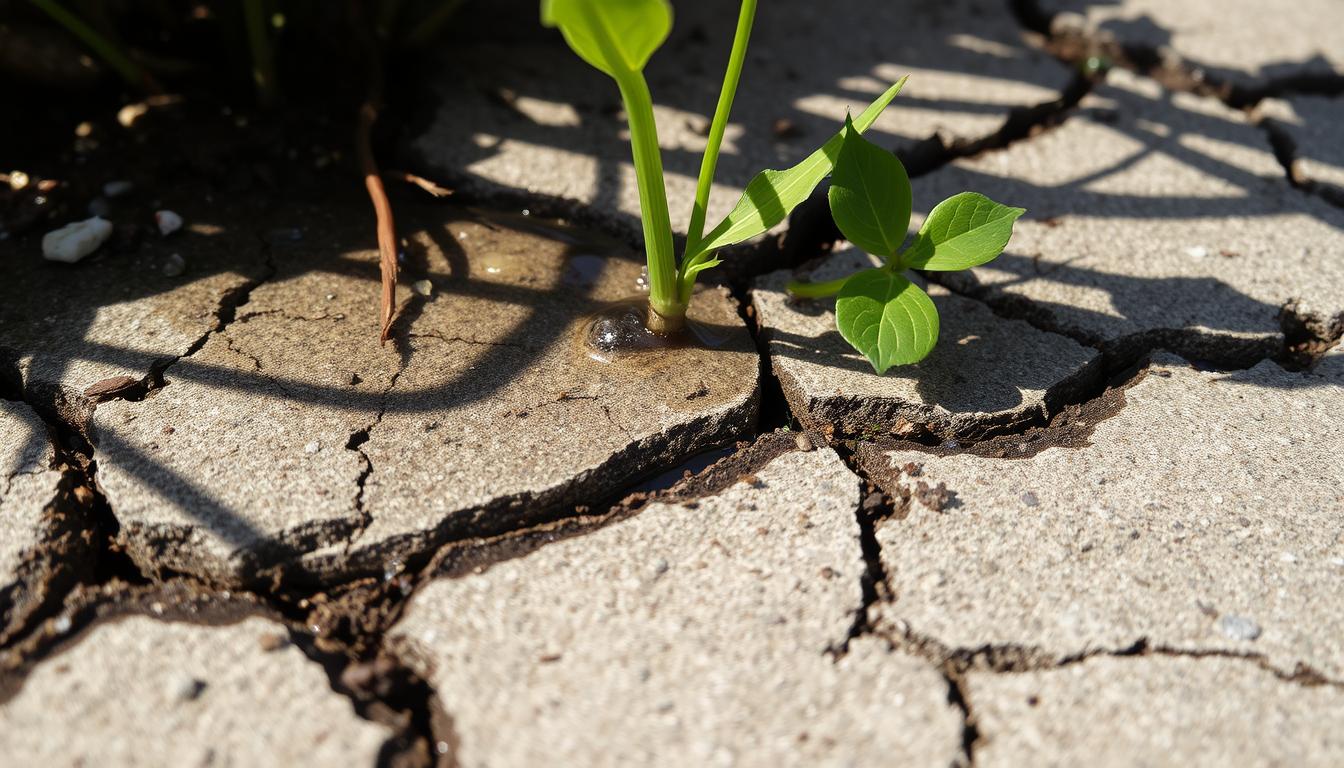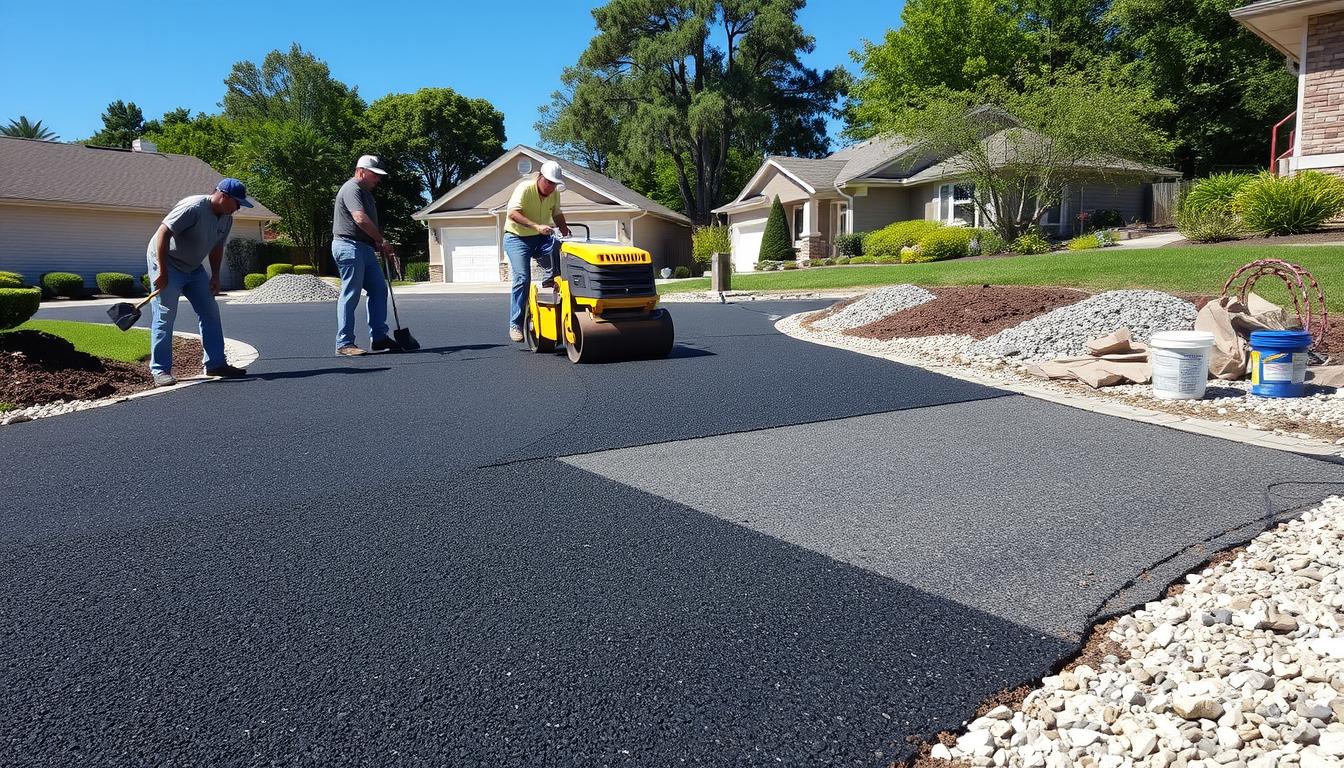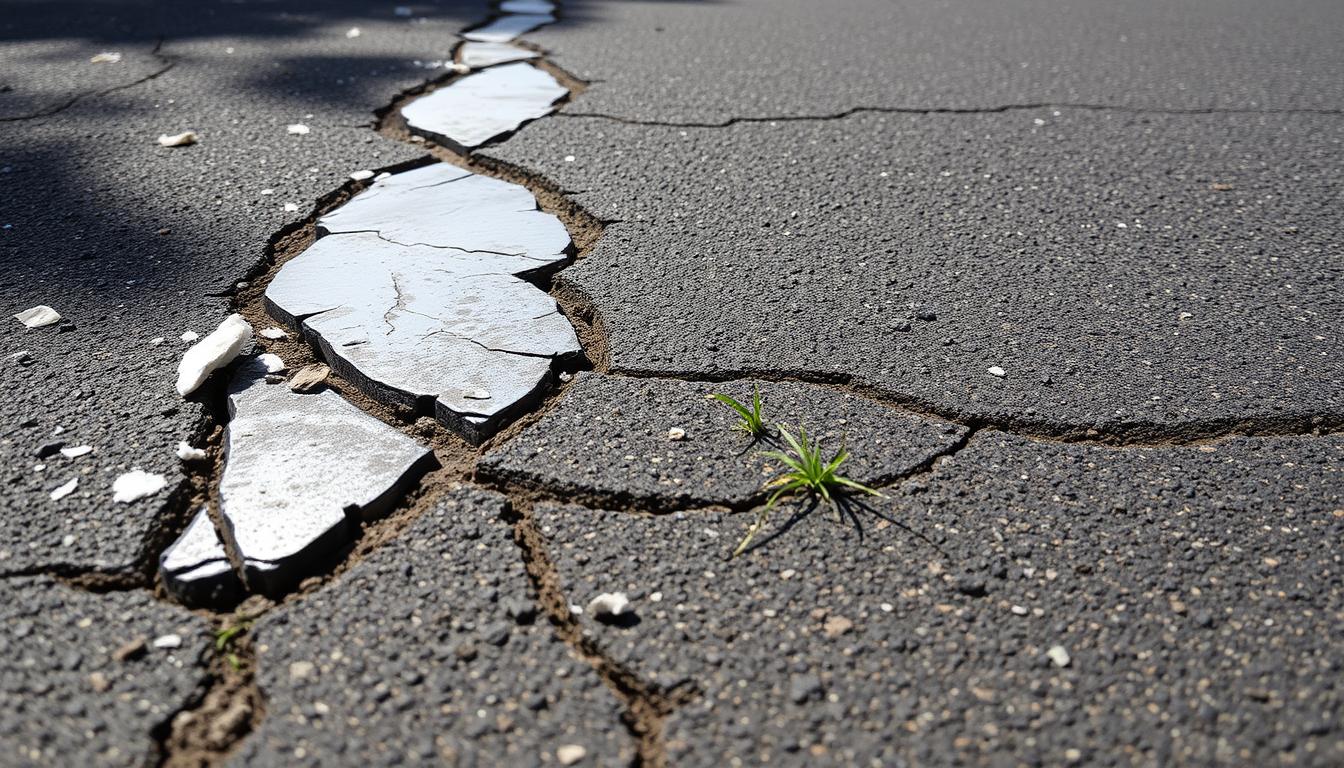Ever wondered What Happens to the Subbase After Asphalt is Removed? Removing asphalt can seriously damage the subbase. This is a big concern for road safety and future repairs.
When asphalt is taken away, the subbase is left open to the elements. This can cause harm. It shows that removing asphalt is not as simple as it seems. Knowing about the subbase is essential for effective repairs and keeping roads safe.
Key Takeaways
- The asphalt cap typically ranges from one to three inches in thickness.
- Immediate exposure can cause damage due to environmental factors affecting the subbase’s integrity.
- Adequate maintenance and timely sealing can extend asphalt’s life and protect the subbase.
- Signs of subbase deterioration include increased cracking, potholes, and changes in pavement structure.
- Regular inspections are vital for identifying issues early and avoiding extensive repairs.
- A solid understanding of asphalt removal techniques can significantly enhance subbase stability.
- Choosing the right contractor is critical to avoid risks from poor asphalt removal methods.
Understanding the Asphalt Removal Process
The asphalt removal process is vital for road maintenance. Knowing the different techniques is important. It helps get the best results and avoids future problems.
Overview of Asphalt Removal Techniques
There are many ways to remove asphalt, each for different needs. Milling grinds the surface for small fixes. Scraping removes the top layer for smaller repairs. Sometimes, everything needs to be removed if the base is too damaged.
Choosing the right method is key. It affects the project’s success now and in the future.
Importance of Proper Removal Methods
Choosing the right asphalt removal techniques is key. Wrong methods can harm the base, leading to costly repairs. Skilled workers with heavy machines, like a Caterpillar 303 excavator, make the process safer and better.
Spending time on planning and doing the removal right can make asphalt surfaces last longer. It also stops problems from happening again.
The Role of the Subbase in Asphalt Structures
The subbase is vital to the strength and life of asphalt structures. It’s made of crushed gravel, soil, or recycled materials. This layer gives a solid base that affects how well the asphalt works.
What Constitutes the Subbase?
The subbase is a layer under the asphalt that helps it stay strong. It can be made of natural soil, crushed stone, or recycled materials. Its main jobs are to help water drain, keep things stable, and protect against frost in cold areas.
Building the subbase right is important. It lets experts check for any problems or wear and tear over time.
How the Subbase Supports Asphalt Layers
The subbase and asphalt layers work together to keep things running smoothly. A good subbase helps the asphalt last longer by preventing cracks and sinking. It also helps the asphalt handle heavy traffic and changing weather.
If the subbase isn’t strong enough, the asphalt can fail early. This means expensive fixes and safety risks. Keeping the subbase in good shape is vital for asphalt to last and work well.
Immediate Effects on the Subbase After Removal
Removing asphalt creates immediate challenges for the subbase. The process exposes it to high stress levels. This can lead to disturbances.
Heavy machinery and traffic increase the risk of compaction. Compaction can damage the subbase’s structure and performance.
Potential Compaction and Disturbances
After asphalt removal, the subbase faces compression from construction equipment. This can cause unexpected shifts or disruptions. If not addressed, these issues might weaken the subbase over time.
It’s important to watch for signs of settling or uneven surfaces. Early action can help maintain the subbase’s strength and function.
Exposure to Environmental Elements
The bare subbase is exposed to environmental elements. Rainfall can cause erosion, washing away fine materials. This can jeopardize the foundation’s stability.
It’s essential to protect the subbase from water intrusion and other environmental factors. Proper management strategies are needed to preserve the subbase’s condition during this vulnerable period.
Long-Term Implications for the Subbase
It’s important to know how the subbase changes after asphalt removal. Over time, erosion and weathering can weaken it. This can harm the support for the asphalt layers.
Risk of Erosion and Weathering
Rain, wind, and temperature changes can slowly damage the subbase. Weathering makes things worse, reducing material quality. Without care, you might need to replace the subbase sooner than expected.
Regular checks can spot problems early. This allows for quick action to prevent bigger issues.
Soil Compaction and Settlement Concerns
Soil gets compacted by constant traffic, making it hard to stabilize. As the soil settles, surfaces become uneven and structures become unstable. This can lead to more damage.
It’s important to tackle soil compaction to avoid major problems. Regular checks and maintenance can help prevent these issues.
Assessing the Condition of the Subbase
Checking the subbase’s condition is key to fixing asphalt after removal. Contractors use special methods to look for problems. This helps keep the road stable and saves money on repairs.
Visual Inspection Techniques
Visual checks are the first step in subbase assessment. Inspectors search for erosion, cracks, or uneven areas. These signs point to deeper issues. Spotting problems early can stop bigger damage later.
Tools Used for Subbase Evaluation
Many tools help in evaluating the subbase. Non-destructive tests like the Falling Weight Deflectometer and more detailed coring are used. Moisture sensors also help understand the subbase’s stability. These tools give a full picture of the subbase’s state. For more on this, visit Assessing Subbase Condition.
Repair and Maintenance Options for the Subbase
Keeping the subbase in good shape is key to a long-lasting asphalt surface. There are many ways to make the subbase stable. This helps avoid expensive repairs later on. Knowing these methods helps you choose the right one for your needs.
Techniques for Stabilizing the Subbase
Methods like grouting, chemical stabilization, and using geotextiles are common. Grouting fills holes in the ground to make the material stronger. Chemical stabilization adds special substances to improve soil strength. Geotextiles add extra support, spreading out loads and stopping erosion.
The Importance of Regular Inspections
Regular checks are vital to keep an eye on the subbase’s health. They help spot problems early, so you can fix them before they get worse. Regular inspections can save you money and keep your pavement in top shape.
Choosing the Right Contractor for Asphalt Removal
Finding a good asphalt removal contractor is key to a successful project. Their experience and approach can make a big difference. Look for someone with the right experience, licenses, and a good track record with customers.
Qualities to Look for in a Professional
Choose a contractor with lots of experience in asphalt paving. Companies like HT Paving and Seal Coating Services have over 30 years of experience. They are reliable and have an A+ rating with the Better Business Bureau (BBB).
Also, check out what other customers say. This will help you understand their service quality.
Why HT Paving and Seal Coating Services?
HT Paving and Seal Coating Services is known for top-notch paving services. They handle small residential jobs and big commercial projects in the Bay Area, California. They use eco-friendly disposal and advanced compaction techniques for a stable sub-base.
For more information, visit their asphalt removal services page. They focus on making customers happy and follow strict safety standards. This makes them a top choice for any project.
Enhancing Subbase Durability Post-Removal
After removing the old surface, making the subbase last longer is key. Choosing the right materials is important for its strength and life. High-quality aggregate mixtures are best because they can handle harsh weather.
These mixtures create a solid base for the new asphalt. This is vital for the asphalt to perform well.
Recommended Materials and Practices
Using strong mixtures helps keep the subbase safe and stable. It’s also important to follow best practices. Regular checks and quick fixes can spot problems early.
Compaction is another key step. It makes sure the base layer is strong enough for heavy traffic.
The Role of Seal Coating in Protection
Seal coating is a must-have for protection. It keeps moisture and UV rays out, which can harm the subbase. Applying seal coat often after laying asphalt helps keep everything strong.
These steps help the subbase last longer and the paving project to last longer too.
Contact HT Paving for Your Asphalt Needs
HT Paving and Seal Coating Services is here to help with your asphalt needs. We focus on quality and safety in every project. Our team is ready to tackle any challenge and deliver top results safely.
Our Commitment to Quality and Safety
At HT Paving, we know that good preparation is key. We use advanced methods and tools to make your asphalt last longer. Our goal is to reduce maintenance by up to 25%, so your asphalt performs better for years.
Schedule a Consultation at (415) 774-6424
Starting an asphalt project needs the right team. Call us at (415) 774-6424 to talk about your project. We’ll create a plan that’s safe, looks great, and saves you money.








